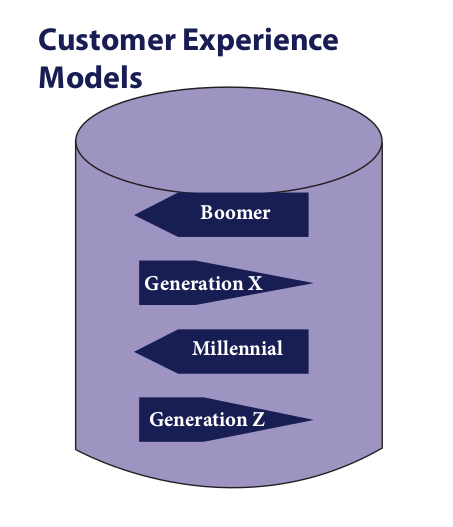What if companies stopped defining their customers in generational terms and instead used generation titles to define a type of customer experience?
I think everyone is familiar with the generational titles, Baby Boomer, GenX, Millennials (Generation Y) and Generation Z. Based on birth dates, these people were born between 1945 and 2010. Many companies use these titles to define their customer segments.
In theory, a Baby Boomer and a Millennial have different likes, dislikes, and attributes; they have different collective expectations regarding how they purchase products and services as well as what determines satisfaction in the purchase journey. For example, one group may require more touch points in the purchase journey while another may require less or, one group may be tech-savvy while another group may be tech-challenged. Most companies devote precious time and money trying to provide the best experience for a wide group of customers.
How would different generational customer experience models be defined?
How would a company move from one customer experience model to another?
Do customer satisfaction levels differ between customer experience models?
Customer Experience Models: Boomer, Generation X, Millennial, Generation Z
What customer experiences characterize these generational titles?
Boomer Customer Experience
-
- Advantages-A Boomer business is built on a singular product; the product becomes the brand. Many Boomer businesses develop a cult following. Operations, including the processes that comprise the purchase journey are honed by experience, typically they are modifications or adaptions of what has worked in the past.
-
- Challenges-The major challenge for the Boomer business is infusing technology into a customer experience that has always been linear in its development. Websites exist, but are merely specification sheets; no electronic interaction is available between the business and the customer. In addition, there is limited back-end technology to accommodate an efficient purchase transaction.
-
- Solutions-Invest in technology; survey customers to determine which technology platform is best suited to accommodate current customers as well as potential customers. Add technology enhancements in increments so that it can be effectively absorbed; establish Net Promoter Score (NPS) baseline to allow further customer experience measurement and improvement.

GenX Customer Experience
-
- Advantages-A GenX business is fully invested in front-end and back-end technology to facilitate two-way communication with customers. The website is fully developed–product/service information is enhanced with meaningful content and it invites social interaction. Back-end technology allows for efficient customer transactions. A Customer Service Team is available to resolve problems.
-
- Challenges-The information flow is often not synced between product/service information and content; out-dated or conflicting information regarding time sensitive data such as stock levels or pricing often detracts from the effectiveness of the website. The Customer Service Team is not adequately trained or empowered to solve problems forcing customers to call back multiple times or have their issue routinely “escalated” to a senior rep.
-
- Solutions-Establish dedicated Website Team including marketing, quality and technology members to optimize the technology supporting purchase journeys. Provide on-going training to Customer Service Teams. Empower Customer Service to eliminate call-backs.

Millennial Customer Experience
-
- Advantages-A Millennial business deploys multiple electronic venues beyond the Website. Webinars, YouTube videos, and social media are used to build deep relationships with customers and solidify brand loyalty. Customer Service Teams are available on “Chat” and depending upon the product or service, 24/7. Investments in new technology are justified to amplify the customer experience.
-
- Challenges- “Personalized” technology is often deployed in a way that makes the customer connection feel impersonal. Example: Enhanced technology (phone-tree-loops) irritates customers. Long wait phone and “Chat” times frustrate customers; customer volume overwhelms Customer Service Teams. Paid Bloggers advocating product or service versus validated customers’ experiences may appear artificial.
-
- Solutions- Balance human and technology interfaces to eliminate “Robot Company” feel. Staff Customer Service Teams to match historical call volumes. Eliminate message, “…Monday and Tuesday are our busiest days, call back another day…” followed by the call being disconnected. Rely on validated customer experiences to promote products and services.

GenZ Customer Experience
-
- Advantages: GenZ businesses effectively match a unique, high quality product or service to the necessary technology platforms to drive customer loyalty.
-
- Solutions: GenZ businesses are driven by personalized customer experience and they use the correct mix of technology to react swiftly to resolve customer problems; they continuously reach-out to customers through several methods to monitor satisfaction levels.
Customer Experience Model Change?
So, what happens when the Boomer, GenX or Millennial Businesses create: Best-in-Class products and services with the right set of technology enhancements leading to loyal customers? They add a “Z” to their title. Boomer changes to BoomerZ, GenX changes to GenXZ and Millennial changes to MillennialZ.
Know any Z Businesses?
An example of a BoomerZ business may be Bantam Bagels featured on the TV show Shark Tank.
Lori Greiner invested in the couple who were clearly a Boomer business; technology enhancements including an ecommerce site were created and business is booming!
How about Amazon as a MillennialZ business?
Which ZBusinesses are your favorite?
November 26, 2016 · Ann Debelack

